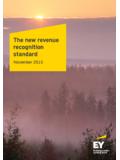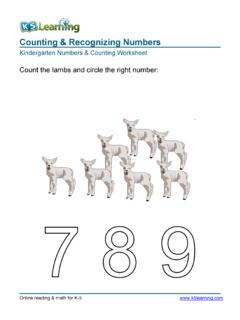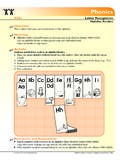Transcription of The Value and ROI in Employee Recognition - …
1 The Value and ROI in Employee Recognition : Linking Recognition to Improved Job Performance and Increased Business Value . The Current State and Future Needs June 2009. Contents Executive 1. 2. The Place of Recognition in the Total Reward 7. From Recognition to Business Value : The Recognition Motivation Engagement Job .. Performance Business Value 10. Measuring the Value of Recognition .. 13. Case Studies: Recognition Programs to Improve Specific Business 24. Conclusions: The Current State and Future Needs of Studies into the Link between Recognition and Business Value :.. 28. Appendix I: Theories of 31. Appendix II: The Future of Measuring the Business Value of 34. 35. i The Value and ROI in Employee Recognition Copyright 2009 Human Capital Institute. All rights reserved. Executive Summary Today's economic challenges require organi- n Organizations actively seeking to improve zations to find new ways to not only reward Employee engagement, including through top performers, but to motivate all workers the use of formal and informal Recognition , to improve performance while maintaining or financially outperform their competitors.
2 Increasing business Value . Both must be done as n Unlike compensation and incentive-based cost-effectively as possible. programs, Recognition programs potentially Traditional methods for keeping and motivat- can create a positive cycle of ever-increasing ing workers utilize compensation and benefits. Employee engagement and motivation with However, as this report emphasizes, those are resulting improvements in job performance- only two parts of an organization's Total Reward related behaviors to optimum levels with a package. In fact, organizations can reward their limited investment. workers in many ways, including with pay, ben- In addition, we present three cases stud- efits, work-life improvements, and incentives for ies Scotiabank, Delta Airlines and MGM. pre-determined job performance as well as Grand that illustrate how some organizations with various forms of Recognition . WorldatWork are restructuring their Recognition programs to defines Recognition as practices that: better align them with Employee engagement and business strategy.
3 A key finding, exempli- Acknowledges or gives special attention to fied by these case studies, is that Recognition Employee actions, efforts, behavior or perfor- programs need to include multiple forms of mance. It meets an intrinsic psychological need awards , what is Recognition for one worker for appreciation for one's efforts and can sup- will not necessarily work with all. In addition, port business strategy by reinforcing certain Recognition programs need not be expensive. In behaviors ( , extraordinary accomplishments) fact, many of the studies we discuss show that that contribute to organizational success. non-cash awards, including simple verbal rec- Whether formal or informal, Recognition pro- ognition, usually work best. What matters is that grams acknowledge Employee contributions the Recognition is valuable to the worker and is immediately after the fact, usually without pre- awarded for behaviors linked to specific job per- determined goals or performance levels that the formance goals.
4 Employee is expected to achieve. Awards can be cash or non-cash ( , verbal Recognition , tro- This report closes with a discussion of the need phies, certificates, plaques, dinners, tickets, etc.). for further studies of Recognition in the work- ( ) place namely we call for: This report highlights Recognition 's role by dem- n New, rigorous empirical studies that accurately onstrating that measure the gains achieved by implementing specific types of Recognition programs. n Recent studies by Gallup, the Corporate n More effective use of Return on Investment Leadership Council, Towers Perrin and others (ROI) and other methods that can better show that Recognition is highly correlated to measure the long-term gains in business Value improved Employee engagement with both that are the hallmarks of successful Recognition the Employee 's work and organization. programs. n Increased Employee engagement has a dramatic positive effect on improving job performance and capturing business Value .
5 1. The results of this National Talent/Employer survey were reported in the Human Capital Institute's National Talents Markets 2009 report. 1 The Value and ROI in Employee Recognition Copyright 2009 Human Capital Institute. All rights reserved. Introduction Bonuses, incentives, rewards and Recognition n Evidence of how increased levels of worker are making headlines today for all the wrong motivation can result in increased Employee reasons. Pulled into the current emotional engagement and improved job performance. environment, these proven organizational per- n Available methods for measuring the effects of formance tools have become the focus of a various types of rewards on job performance one-sided media critique that overshadows or and division/business performance ( , ignores their Value . While any tool can be mis- Return on Investment (ROI), Value on used, these approaches have an evidence-based Investment (VOI), and Lifetime Employee history of providing Value to organizations and Value1) as well as possible reasons for why they their employees.
6 Are seldom used. Several reasons drive individuals employees, n Examples of effective real-world reward employers, taxpayers, politicians and reporters programs what are the common best among them to question the Value or appropri- principles that define them? ateness of incentives or Recognition : In today's global workforce environment, there is competition for: 1) quantity of workers the n efinitions. Most people do not understand D. Baby Boomers are retiring and the generation what incentives or Recognition plans are, or behind them is smaller; 2) quality of workers recognize the differences between the two ( , workers possessing the skills for today's (see Defining the Landscape: Key Terms). economy) and 3) Value from workers the orga- n I neffective use. Some managers and nizational Value obtained from the workforce and organizations do a poor job designing, individual workers.
7 Recognition programs can implementing and managing these tools. help organizations in all three areas by creating n Lack of Value reporting. Generally, the media a culture of Recognition that helps attract and report on only ineffective plans or those with retain top performers and, more importantly, inappropriate outcomes. by improving performance by increasing an These reasons, as well as the need for a com- individual's engagement with his/her job and prehensive review of the available data on employer. Indeed, Recognition has been shown Recognition program effectiveness, inspired this to be particularly effective for increasing produc- research and report. tivity, profit and customer satisfaction (Coffman and Harter, 1999). Further, the Value of recogni- What is the Value of Employee Recognition ? tion programs to an organization, like other What are key elements of effective Employee parts of the rewards package ( , compensa- Recognition programs?)
8 How does one deter- tion, benefits, and incentives), can be measured mine the ROI of Employee Recognition ? It is our despite their more qualitative nature. In fact, a purpose to address these critical and timely key finding that emerges from our review is that questions by reviewing: Recognition is among the best (and certainly n ey theories of motivation ( , intrinsic and K most cost-effective) methods of improving work extrinsic) which are most applicable to the motivation and Employee engagement (see the workplace and have been shown to provide Kanungo and Mendonca, Gallup, and Corporate the most linkage with job performance. (See Leadership Council studies discussed on the fol- Appendix 1.) lowing pages). n he affect or non-affect of various types of T. rewards ( , tangible and non-tangible) upon work motivation. 1. Employee Lifetime Value (ELTV) is a long-term metric of the financial Value of an Employee to an organization.
9 2 The Value and ROI in Employee Recognition Copyright 2009 Human Capital Institute. All rights reserved. Of course, Recognition is but one method of n Reward activities that are linked to specific rewarding workers. Others include pay, benefits, business objectives and/or desired cultural incentives, development and career opportuni- values. ties and various forms of life-work arrangements. n Measure the cost of the Recognition reward Each reward is part of a total incentive program system and the benefits gained whether that should, for optimum results, be integrated through ROI or other methods. with an organization's talent management and The best way to implement a Recognition business strategies. (see Figure 1 and Figure 2, program is as a rational, carefully formulated and accompanying text for two related Total program that is based on sound theory and well Reward models.). Recent studies show that integrated with an organization's business strat- the different aspects of a total reward package egy one that recognizes the behaviors most may affect individual performance, retention likely to positively affect an organization's Value .
10 And business success in different ways (see, , (Daniel, 2005.) In addition, a rational program Harter et. al, 2002 and CLC, 2004). This is par- considers workers' desires, using tangible or tially due to whether a worker views the reward non-tangible rewards that workers Value , so that as an entitlement ( , part of their compensa- they will produce Value in return. (Rath, 2004;. tion) or as something special - aligned to and Huff, 2006.). rewarded for actions beyond the ordinary. Most current Recognition programs may have A key to the success of the Recognition compo- been established for good reasons - , nent of the total rewards package is whether it improving the culture of Recognition within an motivates workers in ways that increase the level organization. However, current studies find that of engagement with their job and their employer. many organizations do not fully integrate the From the organization's viewpoint, engaged various aspects of the program with each other workers will increase their level of discretion- or with business strategy and/or desired culture.






